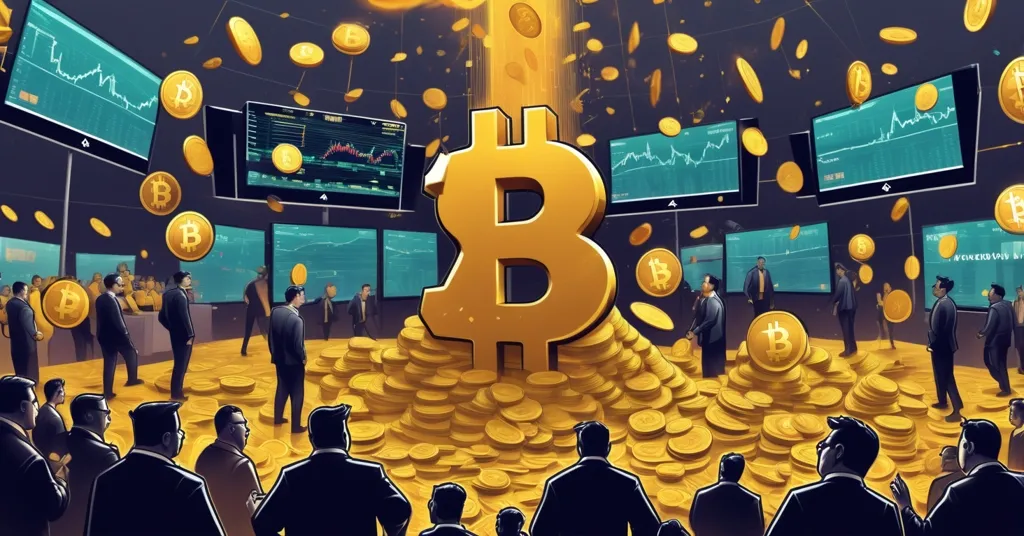Binance Pays $283M After $20B Liquidation Crash and Token Depeg Chaos

Binance Forks Over $283 Million After Token Depegs and Market Meltdown Trigger $20 Billion Liquidation Disaster
Binance, the titan of cryptocurrency exchanges, has shelled out a whopping $283 million to compensate users after a catastrophic market event on a volatile Friday. This chaos, marked by token depegs, price crashes, and a record-breaking $20 billion in liquidations—the worst single-day bloodbath in crypto history—has reignited fierce debates about the stability and accountability of centralized platforms.
- Massive Payout: Binance reimburses $283 million to users hit by token depegs and market crashes.
- Historic Liquidations: A $20 billion wipeout sets a grim record for crypto markets.
- Technical Snafus: Display glitches show altcoins at $0, while Binance Earn assets like USDe plummet to $0.66.
The Glitch That Shook Binance
The turmoil began with a bizarre user interface glitch on Binance’s platform, where several altcoins, including IoTeX (IOTX), Cosmos (ATOM), and Enjin, displayed prices of $0. Before you clutch your chest imagining your portfolio flatlining, rest assured this wasn’t the actual value—it was a visual error. Binance attributed the issue to a tweak in their system: a reduction in the number of decimal places allowed for minimum price movements in certain trading pairs like IOTX/USDT. Think of it like a calculator that’s too lazy to show tiny fractions and just rounds everything down to zero on the screen.
“Certain trading pairs, such as IOTX/USDT, recently reduced the number of decimal places allowed for minimum price movement, causing the displayed prices in the user interface to be zero, which is a display issue and not due to an actual $0 price,” Binance explained.
While this glitch didn’t reflect real market prices, it spooked users during an already tense moment. But the real gut punch came from a separate, far more damaging issue: depegging of assets tied to Binance Earn, a service where users stake or lend crypto for passive income. Three assets—Ethena’s USDe (a synthetic stablecoin engineered to mimic the U.S. dollar’s value through algorithms), BNSOL (Binance’s Solana liquid staking token, representing staked SOL with added liquidity), and WBETH (Wrapped Beacon ETH, tied to Ethereum staking)—lost their intended pegs. Most notably, USDe tanked to $0.66, a far cry from its 1:1 target with the USD. For those new to the game, a “peg” is the stable value an asset aims to maintain; when it “depegs,” chaos erupts as trust and value collapse, often triggering forced sales known as liquidations.
Ethena Labs CEO Guy Young jumped in to defend USDe, arguing the depeg was a Binance-specific anomaly, not a failure of the asset itself across broader markets.
“It is not accurate to describe this as a USDe depeg when a single venue was out of line with the deepest pools of liquidity that experienced no abnormal price deviations whatsoever,” Young stated.
Binance doubled down, claiming the broader market downturn preceded the depegging, dismissing rumors of an external attack or exploit.
“The extreme market downturn occurred before the depegging,” the exchange noted.
Yet, whispers of foul play persist. Pseudonymous trader ElonTrades speculated that Binance’s Unified Account feature—a system letting users manage spot, margin, and futures trading under one account—could have been a weak link, possibly exploited to amplify liquidations. While unverified, this theory highlights lingering distrust in centralized exchanges (CEXs), where users surrender control of their funds to a single entity, unlike decentralized setups where you hold your own keys.
Market Bloodbath: $20 Billion in Liquidations
The fallout was nothing short of apocalyptic. Within a mere 40-minute window—between 21:36 and 22:16 UTC on October 10—Binance users suffered devastating losses across futures, margin trading, loans, Earn redemptions, and internal transfers. The broader crypto market saw $20 billion in liquidations, a figure that dwarfs even infamous crashes like the Terra-LUNA implosion of 2022. For context, liquidations happen when leveraged positions—bets made with borrowed funds—go south, and exchanges forcibly sell your assets to cover the debt. It’s like a casino kicking you out when your chips run dry, except the stakes are your life savings.
To put this $20 billion carnage into perspective, data from platforms like Coinglass suggests it outstrips the May 2021 crash, where leveraged Bitcoin and Ethereum positions unraveled amid China’s mining ban. This recent event underscores how interconnected and fragile crypto markets remain, especially when volatility spikes and centralized platforms falter. Retail investors, often less equipped to hedge against such disasters, took the hardest hits, amplifying calls for better safeguards.
The $283 Million Lifeline
In response, Binance rolled out a $283 million compensation package for affected users during that fateful 40-minute window. This payout, covering a wide range of activities, isn’t pocket change even for a behemoth like Binance. It’s a clear attempt to stem reputational bleeding and reassure users that the exchange has their back. But let’s not kid ourselves—while this move shows accountability, does it set a dangerous precedent? Are we encouraging reckless trading by implying users might get bailed out after over-leveraging? It’s a question worth chewing on as we navigate crypto’s wild west.
Market Recovery: A False Sense of Security?
Remarkably, the crypto market didn’t stay down for long. Binance’s native token, BNB, surged over 11% in just 24 hours post-disaster. The Block’s GM30 Index, tracking the top 30 cryptocurrencies by market cap, also climbed 6.8% over the weekend. It’s almost as if the market shrugged off the chaos faster than a viral meme fades from relevance. But don’t break out the confetti just yet. This rebound, while impressive, masks deeper vulnerabilities—systemic risks tied to leveraged trading, token depegs, and centralized control aren’t magically resolved by a green candlestick chart.
Binance, aware of the optics, announced technical fixes to prevent future debacles. They’re updating their reference index with asset redemption prices and setting a “soft price floor” for USDe to curb wild swings. These are steps in the right direction, but they’re also Band-Aids on a much larger wound. Centralized exchanges have been walking a tightrope since the FTX collapse in 2022, where billions in user funds evaporated due to fraud and mismanagement. Every misstep by Binance—a platform handling billions in daily volume—fuels the narrative that CEXs are ticking time bombs.
Unpacking the USDe Depeg: A Synthetic Stablecoin Under Stress
Let’s zoom in on USDe for a moment, as its stumble raises broader questions about synthetic stablecoins. Created by Ethena Labs, USDe maintains its 1:1 USD peg not through direct dollar reserves like USDT, but via a complex mix of Ethereum collateral and hedging positions on derivatives markets. This algorithmic approach aims to offer stability without centralized backing, but under extreme stress—like the Binance incident—it can wobble. Was this a flaw in USDe’s design, or did Binance’s liquidity management fail to keep up during the liquidation storm? Ethena claims the latter, pointing to stable performance elsewhere. Still, it’s a reminder that synthetic assets, while innovative, carry unique risks in volatile environments—something Bitcoin, with its straightforward scarcity, sidesteps entirely.
Centralization Risks and the Regulatory Shadow
The Binance fiasco has fanned the flames of an ongoing debate: can centralized exchanges be trusted with user funds? Crypto.com CEO Kris Marszalek didn’t hold back, pushing for regulators to scrutinize price swings and technical glitches to shield retail investors from structural failures.
Centralized exchanges must “ensure that retail investors are protected from technical and structural failures,” Marszalek emphasized.
He’s got a point—everyday traders often lack the tools or knowledge to weather these storms. But here’s the flip side: heavy-handed regulation risks choking the very freedom that birthed Bitcoin. The EU’s MiCA framework and the SEC’s recent crackdowns on crypto firms show governments itching to clamp down. Yet, as advocates of decentralization, we must ask—do we want to trade crypto’s rebellious spirit for a sanitized, bank-like system? Bitcoin’s resilience during centralized meltdowns like this one proves you don’t need a middleman to store value. Still, incidents like Binance’s highlight why some guardrails might be needed, especially for newcomers.
Then there’s the Unified Account feature speculation. This Binance tool lets users pool assets across trading types for efficiency, but critics like ElonTrades suggest it could be a vulnerability—centralizing funds in one account might make it easier for bad actors to manipulate positions during volatility. While unconfirmed, it’s a stark reminder that centralization breeds single points of failure, something decentralized exchanges (DEXs) like Uniswap avoid by design. DEXs aren’t perfect—lower liquidity and a steeper learning curve keep them from mass adoption—but they’re a viable alternative for those willing to take custody into their own hands.
Lessons for Crypto Investors
So, what can we take away from this mess? First, over-leveraging is a death trap—borrowing to amplify bets can turn a dip into a disaster. Second, not your keys, not your crypto—parking funds on centralized platforms means trusting someone else with your wealth. Self-custody via hardware wallets like Ledger or software like Electrum offers peace of mind, even if it’s less convenient. Third, diversification across platforms and asset types can mitigate platform-specific risks. And finally, education is your shield—understanding the mechanics of stablecoins, staking, and liquidations can save you from being blindsided. Crypto waits for no one; stay sharp or get burned.
A Bitcoin Maximalist’s Take—With a Nod to Innovation
As someone who leans toward Bitcoin maximalism, I can’t help but raise an eyebrow when altcoins and synthetic experiments like USDe falter. Bitcoin’s elegance lies in its simplicity—no pegs to break, no algorithms to unravel, just pure, scarce, decentralized money. During this chaos, BTC held its ground far better than many leveraged altcoin positions. That said, I’m not blind to the value of innovation elsewhere. Ethereum’s DeFi ecosystem and projects like Ethena push boundaries Bitcoin wasn’t built for, onboarding users through stable assets and yield opportunities. Binance itself, for all its flaws, remains a gateway for millions into this space. We need these experiments, messy as they are, to drive the chaotic progress of effective accelerationism. But let’s be crystal clear: there’s zero tolerance for shoddy infrastructure or scammers. Binance must tighten up—no excuses.
Key Takeaways and Questions Answered
- What caused altcoin prices to display as $0 on Binance?
A user interface glitch from reducing decimal places in trading pairs like IOTX/USDT led to the erroneous $0 display, though actual prices weren’t impacted. - Why did Binance Earn assets like USDe depeg so severely?
Extreme volatility and liquidations on Binance’s platform triggered the depeg, though Ethena Labs notes USDe remained stable in deeper liquidity pools outside the exchange. - Was this disaster due to a hack or exploit?
Binance denies any external attack, pinning the chaos on a pre-existing market downturn, though unverified theories about system vulnerabilities linger. - How did Binance address the impact on users?
They disbursed $283 million to compensate users affected during a 40-minute window on October 10, covering trading, loans, and Earn activities. - Does the quick market recovery mean risks are gone?
Not remotely—BNB’s 11% rally and broader market uptick mask ongoing issues with centralized platforms and leveraged trading vulnerabilities. - Should centralized exchanges face tighter regulation?
It’s a double-edged sword; oversight might protect retail investors but could undermine crypto’s decentralized ethos, a balance we must carefully navigate. - What can crypto users do to avoid liquidation risks?
Avoid over-leveraging, use self-custody for funds, diversify across platforms, and educate yourself on market mechanics to minimize exposure to sudden crashes.
Binance’s latest stumble serves as a brutal wake-up call for the crypto industry. We’re unwavering in our push for decentralization, privacy, and disrupting outdated financial systems, but that doesn’t mean ignoring the glaring cracks exposed by events like this. Crypto holds unmatched potential to redefine money, yet the path to mass adoption is littered with volatility, technical pitfalls, and trust issues. Let’s keep charging ahead—full throttle, no nonsense—but with a clear-eyed view of the challenges. Remember, in this space, complacency is the real enemy. Stay vigilant, hold your keys, and let’s build a future worth betting on.



